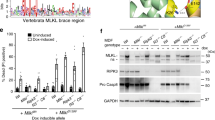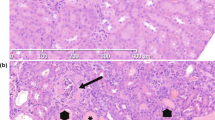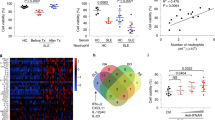Abstract
Chronic granulomatous disease (CGD) is a recessive disorder characterized by a defective phagocyte respiratory burst oxidase, life–threatening pyogenic infections and inflammatory granulomas. Gene targeting was used to generate mice with a null allele of the gene involved in X–linked CGD, which encodes the 91 kD subunit of the oxidase cytochrome b. Affected hemizygous male mice lacked phagocyte superoxide production, manifested an increased susceptibility to infection with Staphylococcus aureus and Aspergillus fumigatus and had an altered inflammatory response in thioglycollate peritonitis. This animal model should aid in developing new treatments for CGD and in evaluating the role of phagocyte–derived oxidants.in inflammation.
This is a preview of subscription content, access via your institution
Access options
Subscribe to this journal
Receive 12 print issues and online access
$209.00 per year
only $17.42 per issue
Buy this article
- Purchase on Springer Link
- Instant access to full article PDF
Prices may be subject to local taxes which are calculated during checkout
Similar content being viewed by others
References
Curnutte, J. in Hematology of Infancy and Childhood (ed. Oski, F. & Nathan, D.G.) 904–977 (Saunders, Philadelphia, 1993).
Jackson, H. & Cochrane, C. Leukocyte-induced tissue injury. Hematology/ Oncology Clin. N. America 2, 317–334 (1988).
Royer-Pokora, B. et al. Cloning the gene for an inherited human disorder — chronic granulomatous disease — on the basis of its chromosomal location. Nature 322, 32–38 (1986).
Dinauer, M.C., Orkin, S.H., Brown, R., Jesaitis, A.J. & Parkos, C.A. The glycoproteln encoded by the X-linked chronic granulomatous disease locus is a component of the neutrophil cytochrome b complex. Nature 327, 717–720 (1987).
Teahan, C., Rowe, P., Parker, P., Totty, N. & Segal, A.W., X-linked chronic granulomatous disease gene codes for the β-chain of cytochrome b-245. Nature 327, 720–721 (1987).
Dinauer, M.C., Pierce, E.A., Bruns, G.A.P., Curnutte, J.T. & Orkin, S.H. Human neutrophil cytochrome b light chain (p22-phox). Gene structure, chromosomal location, and mutations in cytochrome-negative autsomal recessive chronic granulomatous disease. J. clin. Invest. 86, 1729–1737 (1990).
Segal, A.W. et al. Cytochrome b-245 is a flavocytochrome containing FAD and the NADPH-binding site of the microbicidal oxidase of phagocytes. Biochem. J. 284, 781–788 (1992).
Rotrosen, D., Yeung, C.L., Leto, T.L., Malech, H.L. & Kwong, C.H. Cytochrome b558: the flavin-binding component of the phagocyte NADPH oxidase. Science 256, 1459–1462 (1992).
Dinauer, M. The respiratory burst oxidase and the molecular genetics of chronic granulomatous disease. Crit. Rev. clin. lab. Sci. 30, 329–369 (1993).
Roos, D. et al. Chronic granulomatous disease with partial deficiency of cytochrome b558 and incomplete respiratory burst: variants of the X-linked, cytochrome b558 -negative form of the disease. J. leuk. Biol. 51, 164–171 (1992).
Gallin, J. et al. Recent advances in chronic granulomatous disease. Ann. int. Med. 99, 657–674 (1983).
Elsbach, P. & Weiss, J. in Inflammation: basic principles and clinical correlates (eds Gallin, J., Goldstein, I. & Snyderman, R.) 603–636 (Raven Press, New York, 1992).
Odell, E. & Segal, A. Killing of pathogens associated with chronic granulomatous disease by the non-oxidative microbicidal mechanisms of human neutrophils. J. med. Microbiol. 34, 129–135 (1991).
Malech, H. & Gallin, J. Current concepts: immunology. Neutrophils in human diseases. New Engl. J. Med. 317, 687–694 (1987).
Brockdorff, N., Fisher, E.M., Orkin, S.H., Lyon, M.F. & Brown, S.D. Localization of the human X-linked gene for chronic granulomatous disease to the mouse X chromosome: implications for X-chromosome evolution. Cytogenet. Cell Genet. 48, 124–125. (1988).
Baehner, R.L. & Nathan, D.G. Quantitative nitroblue tetrazolium test in chronic granulomatous disease. New Engl. J. Med. 278, 971–976 (1968).
Parkos, C.A., Allen, R.A., Cochrane, C.G. & Jesaitis, A.J. Purified cytochrome b from human granulocyte plasma membrane is comprised of two polypeptides with relative molecular weights of 91,000 and 22,000. J. clin. Invest. 80, 732–742 (1987).
Segal, A. Absence of both cytochrome b-245 subunits from neutrophils in X-linked chronic granulomatous disease. Nature 326, 88–91 (1987).
Knoller, S., Shpungin, S. & Pick, E. The membrane-associated component of the amphiphile-activated, cytosol-dependent superoxide-forming NADPH oxidase of macrophages is identical to cytochrome b559 .. J. biol. Chem. 266, 2795–2804 (1991).
Mayo, L. & Curnutte, J. Kinetic microplate assay for superoxide production by neutrophils and other phagocytic cells. Meth. Enzymol. 186, 567–575 (1990).
Segal, A.W., Jones, O.T.G., Webster, D. & Allison, A.C. Absence of a newly described cytochrome b from neutrophils of patients with chronic granulomatous disease. Lancet ii, 446–449 (1978).
Parkos, C., Dinauer, M., Jesaitis, A., Orkin, S. & Curnutte, J. Absence of both the 91 kD and 22 kD subunits of human neutrophil cytochrome b in two genetic forms of chronic granulomatous disease. Blood 73, 1416–1420 (1989).
Schaffner, A. in Macrophage-Pathogen Interactions (eds Zwilling, B. & Eisenstein, T.) 545–552 (Marcel Decker, New York, 1994).
Schaffner, A., Douglas, H. & Braude, A. Selective protection against conidia by mononuclear and against mycelia by polymorphonuclear phagocytes In resistance to aspergillus. J. clin. Invest. 60, 617–631 (1982).
Diamond, R., Krzesicki, R., Epstein, B. & Jao, W. Damage to hyphal forms of fungi by human leukocytes in vitro: a possible host defense mechanism aspergillosls and mucormycosis. Am. J. Path. 91, 313–328 (1978).
Gallin, J. & Buescher, E. Abnormal regulation of inflammatory skin responses in male patients with chronic granulomatous disease. Inflammation 7, 227–232 (1983).
Xie, Q.-W. & Nathan, C. in Biological Oxidants: Generation and Injurious Consequences (eds Cochrane, C. & Glmbrone, M.J.) 213–235 (Academic, San Diego, 1992).
Shuster, D., Kehrli, M., Ackermann, M. & Gilbert, R. Identification and prevalence of a genetic defect that causes leukocyte adhesion deficiency in Holstein cattle. Proc. natn. Acad. Sci. U.S.A. 89, 9225–9229 (1992).
Padgett, E., Chediak-Higashi syndrome. Adv. Vet. Sci. 12, 239–255 (1968).
Deschenes, S. et al. Comparative mapping of canine and human proximal Xq and genetic analysis of canine X-linked severe combined immunodeficiency. Genomics 23, 62–68 (1994).
Deng, C. & Capecchi, M. Reexamination of gene targeting frequency as a function of the extent of homology between the targeting vector and the target locus. Molec. cell. Biol. 12, 3365–3371 (1992).
McBumey, M. et al. The mouse Pgk-1 gene promoter contains an upstream activator sequence. Nucl. Acids Res. 19, 5755–5761 (1991).
Pevny, L. et al. Erythroid differentiation in chimaeric mice blocked by a targeted mutation in the gene for transcription factor GATA-1. Nature 349, 257–260 (1991).
Robertson, E.J. ed. Teratocarcinomas and Embryonic Stem Cells: A Practical Approach (IRL Press, Oxford, 1987).
Zhen, L. et al. Gene targeting of X-linked chronic granulomatous disease locus in a human myeloid leukemia cell line and rescue by expression of recombinant gp91phox. Proc. natn. Acad. Sci. U.S.A. 90, 9832–9836 (1993).
Du, X., Neben, T., Goldman, S. & Williams, D. Effects of recombinant human interleukin-11 on hematopoietic reconstitution in transplant mice: Acceleration of recovery of peripheral blood neutrophils and platelets. Blood 81, 27–34 (1993).
Ochs, H. & Igo, R. The NBT slide test: a simple screening method for detecting chronic granulomatous disease and female carriers. J. Pediatr. 83, 77–85 (1973).
Heyworth, P.G. et al. Neutrophil nicotinamide adenine dinucleotide phosphate oxidase assembly. Translocation of p47-phox and p67-phox requires interaction between p47-phox and cytochrome b-558. J. clin. Invest. 87, 352–356 (1991).
Dinauer, M.C. et al. Point mutation in the cytoplasmic domain of the neutrophil p22-phox cytochrome b subunit is associated with a nonfunctional NADPH oxidase and chronic granulomatous disease. Proc. natn. Acad. Sci. U.S.A. 88, 11231–11235 (1991).
Savill, J. et al. Macrophage phagocytosis of aging neutrophils in inflammation. J. clin. Invest. 83, 865–875 (1989).
Graybill, J. & Kaster, S. Experimental murine aspergillosis: comparison of amphotericin B and a new polyene antifungal drug, SCH 28191. Am. Rev. Respir. Dis. 129, 292–295 (1984).
Dixon, D., Polak, A. & Walsh, T. Fungus dose-dependent primary pulmonary aspergillosis in immunosuppressed mice. Infect. Immun. 57, 1452–1456 (1989).
Author information
Authors and Affiliations
Rights and permissions
About this article
Cite this article
Pollock, J., Williams, D., Gifford, M. et al. Mouse model of X–linked chronic granulomatous disease, an inherited defect in phagocyte superoxide production. Nat Genet 9, 202–209 (1995). https://doi.org/10.1038/ng0295-202
Received:
Accepted:
Issue Date:
DOI: https://doi.org/10.1038/ng0295-202
This article is cited by
-
ROS inhibition increases KDM6A-mediated NOX2 transcription and promotes macrophages oxidative stress and M1 polarization
Cell Stress and Chaperones (2023)
-
Macrophages disseminate pathogen associated molecular patterns through the direct extracellular release of the soluble content of their phagolysosomes
Nature Communications (2022)
-
Treatment with Polyethylene Glycol–Conjugated Fungal d-Amino Acid Oxidase Reduces Lung Inflammation in a Mouse Model of Chronic Granulomatous Disease
Inflammation (2022)
-
Infections in Patients with Chronic Granulomatous Disease Treated with Tumor Necrosis Factor Alpha Blockers for Inflammatory Complications
Journal of Clinical Immunology (2021)
-
Mice Deficient in NOX2 Display Severe Thymic Atrophy, Lymphopenia, and Reduced Lymphopoiesis in a Zymosan-Induced Model of Systemic Inflammation
Inflammation (2021)



